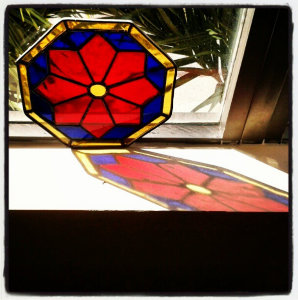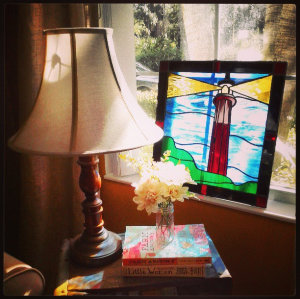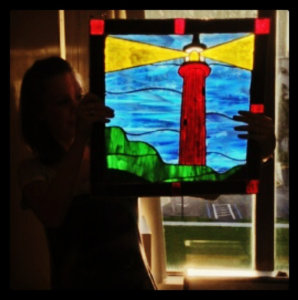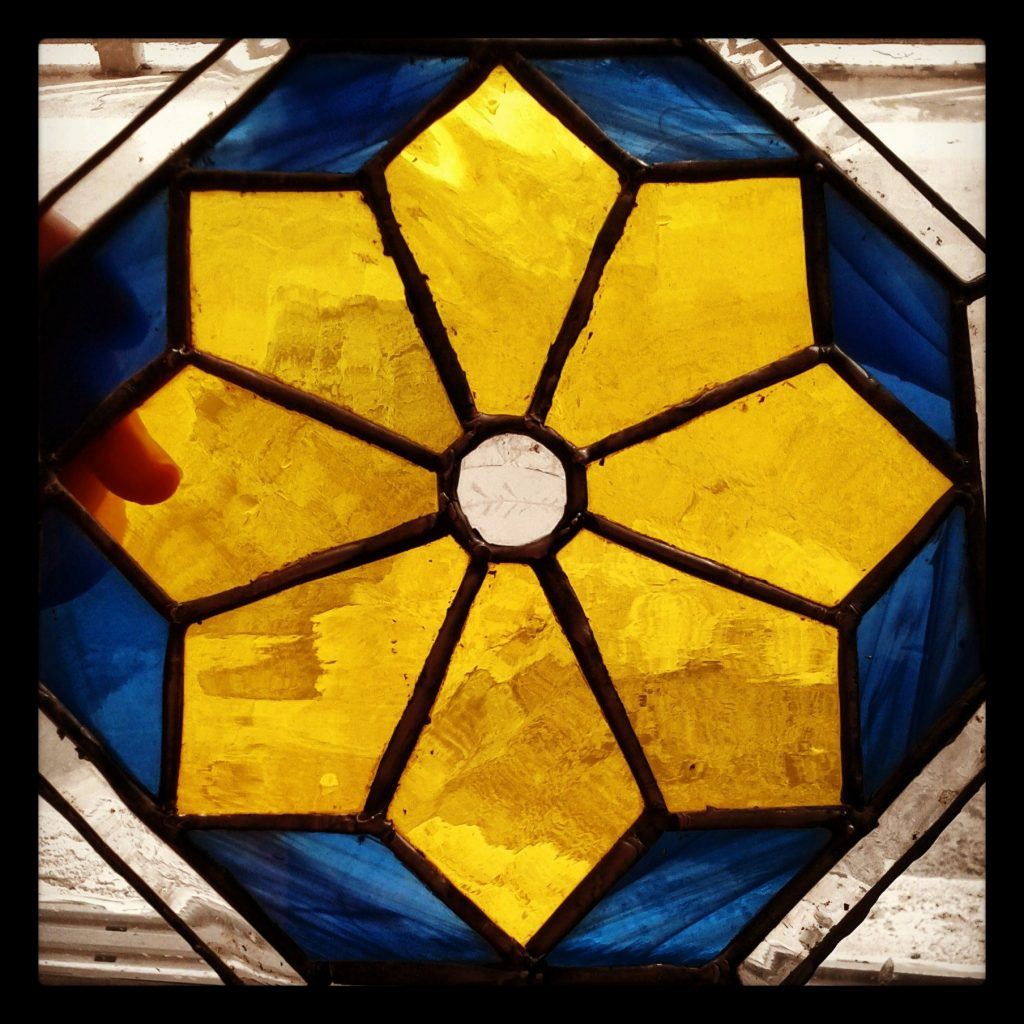Although known for its colors, its stories, and its intricacies, stained glass is not as well-known for its origins. While the specific time of its origin cannot be pinpointed, studies show that the beginnings of stained glass can be traced back to ancient times (Webb). Some of the earliest information available on this glass suggests that it may have been first used by wealthy Romans in their homes in the first century A.D. (Fitzgerald). Other sources say that the development of art glass is first seen in the Middle East, and then used around the world.
However, all sources agree that Christianity caused designed glass to flourish as an artistic medium. Missy Webb suggests that stained glass did not reach its height of popularity until the Christian era. Shannon Fitzgerald puts forward that art glass first started to become popular when Emperor Constantine first allowed Christians to publicly and openly worship freely.
More...
Demand for stained glass began to rise when the number of new church constructions increased around the ninth and tenth centuries. This early Romanesque stained glass was “influenced by the linear patterning, abstraction and severe frontality found in Byzantine Art.” The small colored windows of the period were made predominantly of red and blue, and were surrounded by white glass to let in a much light as possible (Fitzgerald).

With its growth in popularity, stained glass windows also grew in size. The relatively small windows of the Romanesque Period were replaced by the larger stained glass windows created to fit “immense window spaces in Gothic cathedrals” (Fitzgerald). Within the Gothic style, a more full development of the concept of art glass was brought about.
As the popularity of these colorful windows continued to increase, they first gained popularity within churches. “The History of Stained Glass” gives us insight into the implementation of stained glass into the monastery of St. Denis. “[Abbot Suger] brought in craftsmen to make the glass and kept a journal of what was done. He truly believed that the presence of beautiful objects would lift men’s souls closer to God.”
Missy Webb tells us that when making stained glass windows, certain colors of glass were used to convey emphasis on a certain subject. Shannon Fitzgerald elaborates on the colors of glass popular at the time. She articulates that within the Gothic period, “Red and blue remain the predominant color choice, and the tendency to fuse white glass in the composition allowing for more light gives way to completely filling up of space with ornate designs consisting of darker glass.” Missy Webb tells us that with the larger windows, “a light philosophy (‘God is light’) was expressed, and it was thought that light reflected on earth is the closest we can get to the divine.” The “God is light” philosophy as well as the confidence that beauty can draw a heart to contemplate the manifold glories of God are two reasons that began and continue to make stained glass popular within churches.
Although the primary purpose of stained glass was to add beauty to churches, its secondary purpose is often overlooked. Since the art of stained glass was created to depict scenes from the biblical narrative, colored glass not only served as a means of adding beauty, it also served as a teaching aid (Oliver, Megan). To expand upon this point, Ms. Oliver tells us that the reason stained glass was included in a church was to serve a dual purpose.

It not only drew men’s hearts closer to God through its beauty, but it was also used as a teaching method. By “using symbolic abstraction, the story being depicted [in glass] was easily understood by even the most illiterate people, and [was] used [for teaching] of [the] faith.” Besides being beautiful and drawing men’s hearts to contemplate the manifold majesties of God, these decorated windows used the portrayal of a narrative as a teaching mechanism for the illiterate.
The Art Glass Association gives readers a description of a stained glass window that one might see in the Gothic era serving this dual function.
“Gothic stained glass windows are a complex mosaic of bits of colored glass joined with lead into an intricate pattern illustrating biblical stories and saints lives. Viewed from the ground, they appear not as a picture but as a network of black lines and colored light. Medieval man experienced a window more than he read it. It made the church that special, sacred dwelling place of an all powerful God” (Art Glass Association).
Following the Gothic Style and with the beginnings of the Renaissance in the fourteenth century, the formation of stained glass began to take on a different form. Stained glass windows “lost all their previous glory and it seemed the original symbolism and innate beauty of stained glass was forgotten…[for] windows were white glass heavily painted.” In the fifteenth century at the zenith of the high Gothic, the painting of the glass became more convincing. Colored glass also left the realm of just churches and entered the more public sphere of other buildings as well as homes (Art Glass Association).
The Renaissance came to a close, and the next major era of stained glass was in the nineteenth century. In this century, stained glass became a popular art form in America. Louis Comfort Tiffany and John LaFarge were two painters in America who expanded their horizons from painting and began experimenting with tinted glass. These two men soon became competitors as they tried to produce pleasing visual effects without the use of paint. They began using glass and were both successful with its creative use, but it was Tiffany who we came to associate with opalescent windows and lamp shades. It was Tiffany who ultimately became popular and well-known for his work in stained glass (“The History of Stained Glass.”).
After the deaths of both Tiffany and LaFarge in the early 1900s, stained glass waned in popularity. Until after WWII, the popularity of stained glass stayed in decline except in churches, though it changed stylistically. The stained glass windows of many of these churches include an “atmosphere of light and color” as opposed to easily identifiable scenes (“The History of Stained Glass.”). At the end of the twentieth century, interest in stained glass again surged in popularity. There are many ways of expressing oneself through this art. It has become a hobby and has given rise to what is called, “a new golden age in glass” (“The History of Stained Glass.”).

The progression of stained glass from its beginning to the modern day as an art form has gone through many changes both functionally and stylistically. Stained glass has evolved from a skill reserved for professionals to an art form accessible even to college students. However, one thing has remained the same. Throughout its history, stained glass has remained popular within the church of Christ.
The beauty of stained glass can still bring men’s hearts closer to God as worshipers reflect upon the majesty and glory of the Creator. Stained glass art draws our hearts to reflect on how the “light of the world” became incarnate. Jesus Christ lives so that He may shine His light to those who have been “darkened in their understanding” (Ephesians 4.18, ESV). The light and color of this decorative glass can remind us that Christ came so that we may “walk as children of light” (Ephesians 5.8). Stained glass reminds us that “Splendor and majesty are before [God]; strength and beauty are in his sanctuary” (Psalm 96.6). We are like stained glass in that we do not perfectly reflect what the Creator originally intended. But as His handiwork, God continually fashions us into the image of His Son (Ephesians 2.10). His light and beauty can still be clearly seen through us, even through our flaws. The splendor of stained glass possesses the unique characteristic of pointing men toward heaven—and the God of heaven. If we allow it to, stained glass can remind us that “He has made everything beautiful in its time [and] has also set eternity in the hearts of men; yet they cannot fathom what God has done from beginning to end” (Ecclesiastes 3.11).
Works Cited
Fitzgerald, Shannon . “History of Stained Glass.” UW-Milwaukee. UW-Milwaukee, n.d. Web. 16 Feb. 2013. <http://www4.uwm.edu/letsci/arthistory/StainedGlass/history.cfm>.
Oliver, Megan. “Lessons of Faith in Glass- Stained Glass Windows:Decoration or Inspiration? by Megan Oliver - Eastertide 2008.” Women for Faith and Family Home Page. N.p., n.d. Web. 10 Feb. 2013. <http://www.wf-f.org/08-1-StainedGlass.html>.
“The History of Stained Glass.” Art Glass Association. Art Glass Association, n.d. Web. 10 Feb. 2013. <http://artglassassociation.info/history.htm>.
Webb, Missy. “History of Stained Glass Windows in the Church - Yahoo! Voices - voices.yahoo.com.” Yahoo! Voices. Yahoo! Inc., n.d. Web. 10 Feb. 2013. <http://voices.yahoo.com/history-stained-glass-windows-church-377219.html>.

